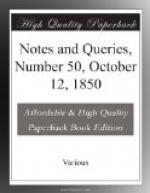His published works, as far as I can learn, are as follows:— {317}
1. A Trip to Holland, 1801.
2. Socrates, a dramatic poem, 8vo. 1806.
3. Lucianus Redivivus,
or Dialogues concerning Men, Manners, and
Opinions, 8vo. 1812.
4. Shakspeare’s
Himself, or the Language of the Poet asserted;
being a full but dispassionate
Examin of the Readings and
Interpretations of the several
Editors, 2 vols. 8vo. 1815.
EDWARD F. RIMBAULT.
Passage in Vida (Vol. i., p. 384.).—Your correspondent A.W. asks for some light on the lines of Vida, Christiad, i. 67.:
“Quin age, te incolumi potius....
...
Perficias quodcumque tibi nunc instat
agendum.”
He cannot construe “te incolumi.” No wonder. Will not all be set right by reading, “Quin age, et incolumi,” &c.?
J.S.W.
Stockwell, Sept. 7.
“Quem Deus vult perdere” (Vol. i., p. 347., &c.).—To the illustrations of the saying “Quem Deus vult perdere prius dementat,” which have been given, may be added the following from the Fragments of Constantinus Manasses (edited with Nicet. Eugen., by Boissonade. Paris, 1819), book viii. line 40.:—
[Greek: “Ho gar theos aptomenos
anthropou dianoias
Haenika to dusdaimoni kirnaesi penthous
poma,
Ouden pollakis sugchorei bouleusasthai
sumpheron.”]
J.E.B. MAYOR.
Marlborough College.
Countess of Desmond (Vol. ii., pp. 153. 186.).—R. is referred to Smith’s History of Cork, and European Magazine, vol. viii., for particulars respecting the Countess of Desmond. They show her picture at Knowle House, Kent, or Penshurst (I forget which); and tell the story of the fall from the cherry (or plum) tree, adding that she cut three sets of teeth!
WEDSECNARF.
Confession (Vol. ii., p. 296.).—The name asked for by U.J.B. of the Catholic priest, who, sooner than break the seal of confession, suffered death, is John of Nepomuc, Canon of Prague. By order of the Emperor Wenceslas, he was thrown off a bridge into the Muldaw, because he would not tell that profligate prince the confession of his religious empress. This holy man is honoured as St. John Nepomucen on the 16th of May, in the kalendar of Saints.
D. ROCK.
[U.J.B., if desirous of further
particulars respecting St. John
Nepomuc, may consult Mrs.
Jameson’s interesting Legends of the
Monastic Orders, pp. 214.
217.—ED.]
Cavell, meaning of (Vol. i., p. 473.).—I concur entirely with the etymology of the word cavell given at p. 473. A lake having been drained in my country, the land is still divided into Kavelingen; as lots of land were formerly measured by strings of cord, kavel, kabel, cable. Vide Tuinman Trakkel, d. n. t. p. 165. Kavelloten is to receive a cavell by lot. cf. Idem, Verrolg, p. 97.




